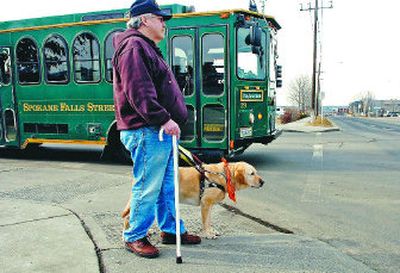Hybrid cars create silent danger for blind

Noisy cars are a bad thing, right?
Maybe not … at least not for people who are blind or visually impaired. Hearing a car approach is one of the only ways they have as pedestrians to safely navigate local streets.
Super-quiet hybrids pose a new kind of danger, and some national advocates for the blind are pushing for modifications that would cause the cars to make a little more noise.
Locally, a group of blind and sight-impaired people who meet regularly at the Lilac Blind Foundation recently discussed the risks created by hybrids and other quiet cars.
“We have heard complaints that it’s harder to determine when it’s safe to cross,” said Lilac Blind Foundation Executive Director Cheryl Martin.
Members said they’ve been hit by non-hybrid cars and had their canes broken when cars ran over the tips. Hybrids will likely exacerbate the problem, they said.
Laurie Kennedy, who belongs to the group and can’t see, suggested that hybrid cars be outfitted with something on the wheels that makes sound.
With or without such devices, the best solution is for drivers to watch for pedestrians, especially the sight-impaired.
“The driver has to be aware. Half of them, they’re not,” Kennedy said.
White-cane laws in every state give visually impaired pedestrians with white canes or guide animals the right of way no matter what the situation.
George Davis, who used to drive but no longer does because he can’t see well enough, said that those learning to drive would benefit from training showing them what it’s like to get around blindfolded with a cane.
“I think most of us are crossing the street on a wing and a prayer,” he said.
Got $32 million?
The Washington State Department of Transportation is $32 million short of what it needs to finish a section of the North Spokane Corridor between Francis and Wandermere.
Fuel, asphalt, concrete and steel price increases have driven the project’s cost sky-high.
Just five years ago, engineers estimated it would cost $189 million to build the northern section currently under way. Today that figure has ballooned by 71 percent, to $323 million.
The state allocated another $102 million to the corridor, but that still leaves a $32 million hole to finish the current projects.
Spokane Sen. Chris Marr, who sits on the Washington state Senate Transportation Committee, said he’s determined to get that money into the state budget.
The problem is that projects all over the state have the same problem, to the tune of $1.8 billion, Marr said.
“We’re scrambling to come up with ways to fulfill the promises we made to people,” he said.
Many of those projects were promised to the public when the state last raised the gas tax. When that gas tax increase was put to voters, Spokane area residents largely turned it down.
That is a bit problematic when it comes to getting buy-in from other legislators to send more money this way, said Marr.
But he added that he remains optimistic and determined to make the North Spokane Corridor project whole.
“I need this one to go home,” Marr said.
Slow going
Washington Street is scheduled to be closed during the day from Buckeye Avenue to Indiana Avenue this month as water crews work there. Local access will be maintained.
The right-hand lane of Ash Street will be closed for about a month from Garland Avenue to Wellesley Avenue so that a water main can be installed.
One lane of Crestline Street will be closed between Lacrosse Avenue and Longfellow today through Thursday.
Work at Wellesley Avenue and Division Street could slow traffic this week.
Work on Regal Street between 30th and 44th avenues will cause some lane closures this week.
Market Street traffic is detoured at Freya and Regal.
Mission Avenue is closed this week for sewer construction between Woodruff and University Roads.